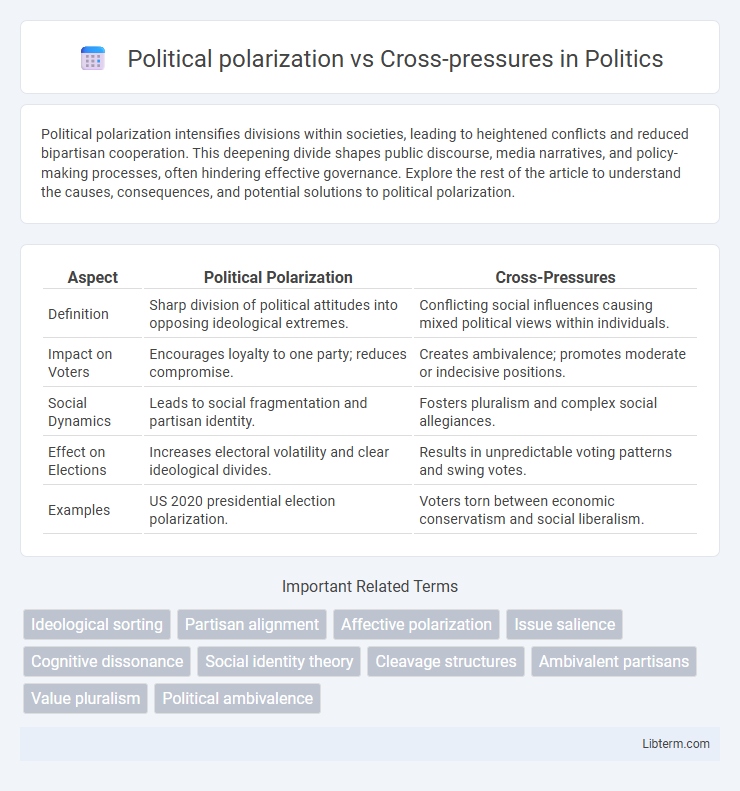Political polarization intensifies divisions within societies, leading to heightened conflicts and reduced bipartisan cooperation. This deepening divide shapes public discourse, media narratives, and policy-making processes, often hindering effective governance. Explore the rest of the article to understand the causes, consequences, and potential solutions to political polarization.
Table of Comparison
| Aspect | Political Polarization | Cross-Pressures |
|---|---|---|
| Definition | Sharp division of political attitudes into opposing ideological extremes. | Conflicting social influences causing mixed political views within individuals. |
| Impact on Voters | Encourages loyalty to one party; reduces compromise. | Creates ambivalence; promotes moderate or indecisive positions. |
| Social Dynamics | Leads to social fragmentation and partisan identity. | Fosters pluralism and complex social allegiances. |
| Effect on Elections | Increases electoral volatility and clear ideological divides. | Results in unpredictable voting patterns and swing votes. |
| Examples | US 2020 presidential election polarization. | Voters torn between economic conservatism and social liberalism. |
Introduction to Political Polarization
Political polarization refers to the growing ideological distance and division between political parties and their supporters, leading to increased partisan loyalty and reduced bipartisan cooperation. Cross-pressures occur when individuals face conflicting influences from different social groups or identity affiliations, which can moderate extreme political views and reduce polarization. Understanding the dynamics of polarization and cross-pressures is essential for analyzing voter behavior and the stability of democratic institutions.
Understanding Cross-Pressures in Politics
Cross-pressures in politics occur when individuals encounter conflicting influences from various social groups, such as race, religion, or socioeconomic status, leading to ambivalent political attitudes and voting behavior. Unlike political polarization, which pushes individuals toward extreme partisan positions, cross-pressures create internal tensions that moderate political opinions and increase electoral unpredictability. Understanding cross-pressures reveals why some voters resist strict party alignment and instead exhibit more nuanced or swing voting patterns in elections.
Causes of Political Polarization
Political polarization primarily arises from ideological sorting, where individuals increasingly align with political parties reflecting their social identities and values, deepening partisan divisions. Media fragmentation and echo chambers amplify selective exposure to information, reinforcing existing beliefs and limiting cross-cutting interactions. Economic inequality and cultural conflicts also intensify polarization by heightening perceptions of zero-sum competition between groups.
Origins and Dynamics of Cross-Pressures
Cross-pressures originate from individuals holding conflicting social identities or values that cut across traditional political alignments, creating internal conflicts that moderate partisan views. These pressures emerge from factors such as class, religion, ethnicity, or occupation, which intersect and dilute the intensity of political polarization within a society. The dynamics of cross-pressures contribute to political moderation by fostering nuanced opinions and reducing the likelihood of extreme partisanship.
Impact of Polarization on Society
Political polarization intensifies divisions within society by reinforcing echo chambers and limiting exposure to diverse viewpoints, which undermines social cohesion and democratic deliberation. Cross-pressures, arising from individuals holding conflicting social identities or interests, can moderate extreme partisan attitudes but are weakened in polarized contexts. The erosion of cross-pressures due to heightened polarization leads to increased social fragmentation, reduced trust in institutions, and greater difficulty in achieving collective action or consensus.
Effects of Cross-Pressures on Individual Behavior
Cross-pressures create internal conflicts in individuals by exposing them to conflicting social group affiliations, political beliefs, or cultural norms, leading to moderated political attitudes and reduced partisan polarization. These conflicting influences often result in ambivalence or political indecision, decreasing the likelihood of strong, cohesive party alignment. Empirical studies show that individuals experiencing cross-pressures exhibit greater openness to alternative viewpoints and more nuanced voting behavior compared to those firmly embedded in polarized groups.
Polarization vs. Cross-Pressures: Key Differences
Political polarization intensifies ideological divisions, driving individuals toward more extreme and rigid policy positions, while cross-pressures create internal conflicts by exposing voters to conflicting influences from social groups, values, or identities. Polarization sharpens partisan loyalty and reduces compromise, whereas cross-pressures foster ambivalence and moderate political views. Understanding these differences is crucial for analyzing voter behavior and predicting electoral outcomes in highly fragmented political environments.
Interplay Between Polarization and Cross-Pressures
Political polarization intensifies ideological divisions, while cross-pressures create conflicting loyalties that complicate voter behavior and party alignment. The interplay between polarization and cross-pressures shapes electoral outcomes by increasing voter ambivalence and reducing partisan consistency. This dynamic interaction influences political stability and policy-making effectiveness in democratic systems.
Strategies to Mitigate Political Polarization
Effective strategies to mitigate political polarization include promoting cross-pressures that encourage individuals to hold diverse social identities and affiliations, which can moderate extreme partisan views. Encouraging inclusive dialogue platforms and bipartisan policy initiatives helps bridge ideological divides by fostering understanding and cooperation across party lines. Implementing educational programs that enhance critical thinking and media literacy further reduces susceptibility to echo chambers and partisan misinformation.
Promoting Cross-Pressure for Democratic Deliberation
Promoting cross-pressure in democratic deliberation enhances diverse perspectives by encouraging individuals to consider multiple, conflicting social identities and interests, which reduces political polarization. This mechanism fosters open-minded dialogue and critical thinking, leading to more nuanced, compromise-oriented policy decisions. Empirical studies show that cross-pressured citizens demonstrate greater tolerance and are less prone to extreme partisan divisions, strengthening democratic resilience.
Political polarization Infographic

 libterm.com
libterm.com